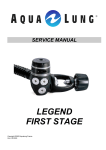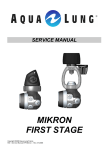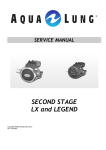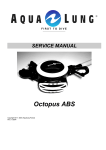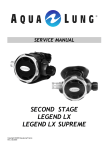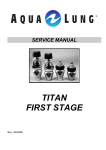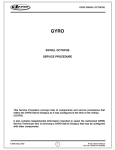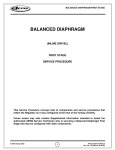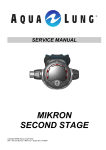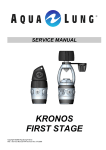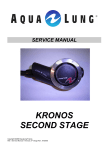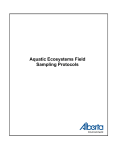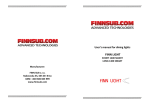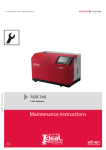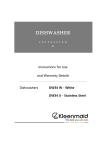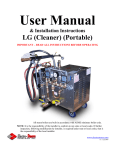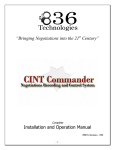Download Connection ACD Legend (Din & Yoke )
Transcript
Technical Manual Connection ACD Legend (Din & Yoke ) Copyright ©2005 Aqualung France Reference document : ME LACD_EN Rev. 10.2005 ME LACD_EN Rev.10.2005 F I R S T T O D I V E Legend ACD connection technical manual index COPYRIGHT............................................................................................................................... 3 INTRODUCTION........................................................................................................................ 3 WARNINGS, ATTENTION, NOTE …… ……............................................................................. 3 MAINTENANCE......................................................................................................................... 3 GENERAL INSTRUCTIONS .................................................................................................. 3 GENERAL CONVENTIONS.................................................................................................. 4 Disassembly / reassembly yoke connexion………......................................................................5 Disassembly / reassembly Din Connexion … ……………...........................................................7 List of tools and service kits ……………………..........……………........................................... 10 Cleaning and lubricating Exploded views 2 ME LACD_EN Rev.10.2005 F I R S T T O D I V E Legend ACD connection technical manual COPYRIGHT This manual is the property of Aqualung France. Any copying, photocopying, reproduction, translation, electronic distribution (email, Internet...), even partial, and in whatever format, is expressly forbidden without the written consent of Aqualung France. GENERAL INSTRUCTIONS 1. In order to carry out the procedures described in this manual correctly it is important that you follow the steps in the exact order indicated. Read the manual through completely so that you become familiar with all the procedures, the special tools and the replacement parts, before starting to disassemble the product. Keep this manual open near to you so that you can refer to it step by step. Do not rely on your memory.. 2. All servicing and repair procedures should be carried out in a workshop that is clean, well lit, easy to access and specially fitted for the purpose. 3. The regulator body should never be directly held in the jaws of a vice. To hold the body, screw the tool 006230 into the HP port and then grip the tool with the vice. 4. Once the regulator has been disassembled, the reusable components should be separated from the components that need to be replaced. Fragile items with seats or crowns with critical sealing surfaces should be separated and protected during servicing in order to prevent any damage. 5. Use only spare parts from Aqualung service kits. Never replace an Aqualung part with one from another manufacturer, even if it appears similar. 6. Never re-use regulator parts which should be replaced on the pretext that the regulator has seen little use since its manufacture or since its last service. 7. When reassembling, check that the torque used conforms with that shown in Table 4, Torque. Some parts can be irretrievably damaged if the acceptable torque is exceeded. ©2005 Aqua Lung France. INTRODUCTION This manual gives the instructions and the recommendations for the disassembly, the cleaning, the checking, the reassembly and the adjustment of an Aqualung regulator. This manual is not an instruction manual for unqualified personnel. The procedures described in this manual are intended only for qualified personnel who have been trained in the servicing of Aqualung equipment during a specialised course. If you do not understand certain procedures in this manual you should contact an Aqualung service consultant before undertaking any operation. WARNINGS, ATTENTION, NOTES Certain icons have been used to facilitate the reading and understanding of this manual. They have the following meanings : . WARNING: Indicates situations that could result in serious or fatal accidents if the advice given is not followed correctly. . ATTENTION: Indicates a situation or action that could cause serious damage to the product, making it dangerous if the advice given is not followed correctly. NOTE : Notes are used to emphasize important points as well as information which needs to be remembered. MAINTENANCE Attention: Whatever the number of dives carried out during a year, the regulator should receive a complete service each year. If the regulator is used in a chlorinated or aggressive environment the service period should be reduced to six months. In order to conform with the Aqualung Regulator Lifetime Guarantee, all servicing (inspection, servicing and repairs) should be recorded in the Service Record incorporated in the regulator User Manual. 3 GENERAL CONVENTIONS The conventions described below define the actions to be carried out when an instruction is given. 1. Unscrew: to unscrew a threaded part, turn it anticlockwise. 2. Screw: to screw a threaded part, turn it clockwise. 3. Remove the O-ring: To remove an O-ring follow the method below, using the special tool provided for this purpose. Any tool that could damage the O-ring should be avoided. In every case, replace the O-ring removed with a new one. Press simultaneously on the two sides of the O-ring in order to form an ‘eye’. . Insert the special tool into this eye to remove the O-ring. ME LACD_EN Rev.10.2005 F I R S T T O D I V E Legend ACD connection technical manual LP: Low Pressure MP: Medium Pressure HP: High Pressure 4. Numbers in brackets indicate the part number of the component shown on the exploded view attached. DISASSEMBLY PROCEDURE Note: Before commencing disassembly, consult the exploded view to check the reference numbers of all parts requiring replacement. These parts should all be replaced by new parts and should not be re-used on the pretext that the regulator has seen little use since its manufacture or since its last service. Attention: Use only the special tool when removing O-rings in order to avoid damaging the seal recess. The slightest scratch on a sealing surface could cause a leak. If a surface should be damaged then this part should be replaced with a new one. Do not use any pointed instrument or metal tool to remove O-rings. 4 ME LACD_EN Rev.10.2005 F I R S T T O D I V E Legend ACD connection technical manual 5 Yoke Connection (see Exploded view : 129220) 1.Thread a visemounting tool into one of the ports. Securely clamp tool into vise with yoke connection facing up. Remove the yoke screw and dust cap. Using a large crescent wrench, remove the inlet fitting. Remove the body from the vise. Remove the tool from the body. 2. remove the filter and the o-ring (35) with the seat extraction tool End of the disassembly of the yoke connection Before starting to re-assemble the regulator, make sure that all replacement parts have been cleaned and lubricated in accordance with Procedure A: Cleaning and Lubricating . Re-assembly procedure (Yoke connection ) 3. With the yoke retainer (35) placed into the yoke, compress the plastic dust cap between the yoke retainer and the yoke screw, carefully clamp the yoke retainer in a vise by the wrench flats. With a 3 mm Allen key, turn clockwise to unscrew the yoke shutter valve (32). 1.Fit a new o-ring into the groove, (use the plastic end of the seat fitting tool to help ) and lubricated it. 4. Remove the yoke screw and the dust cap to disassemble the ACD valve . Remove the spring (34), the o-ring (33), the shutter valve (32), and the o-ring (28), inside the groove of the shutter crown. 2. Install the shutter valve (32) inside the shutter crown (31), then fit in a lubricated o-ring (33). ME LACD_EN Rev.10.2005 F I R S T T O D I V E Legend ACD connection technical manual 6 8. remove the assembly from the vise, remove the yoke screw (30) 3. Install the spring (34) into the yoke retainer (35 ) Check that the shutter crown shoulder is about 1.5 mm ( 0.4 inches ) above the retainer. Push down with your finger against the Crown shutter to confirm the ACD works. 4. Place the shutter crown (31) onto the spring , put the subassembly into the yoke . 5.Install the dust cap between the yoke and the shutter crown, then tighten the yoke screw (30) so that the spring is compressed. 6. Stop tightening when the crown is set in this position. In this position the yoke screw becomes hard to turn. 7.Position the yoke retainer with threads facing upward, using a 3mm allen key, turn counter-clockwise 3 full turns. 9. Turn over the sub assembly and fit in a new o-ring (28) and a new filter (36). 10.While holding the body in an inverted position, thread the yoke / retainer subassembly up, into the body until snug. Using a vise-mounting tool, install the regulator into a bench vise. Using a torque wrench with the Aqua Lung A11001 socket, tighten the inlet fitting to 18 ft/lbs (2.5m.kg). Tighten the yoke screw again, so that dust cap is snug against the yoke retainer 11. Install the dust cap on to Clamp the yoke retainer (35) by the two wrench flats into a vise . Using a torque wrench and a 3mm allen key adapter, torque the yoke shutter valve (32) to 18 in.lbs ( or 0.2 m.daN ). the yoke screw so that the Aqua Lung logo faces outward. Thread the yoke screw into the yoke. End of the assembly ACD yoke For the rest of the first stage assembly, see the Legend technical manual. ME LACD_EN Rev.10.2005 F I R S T T O D I V E 7 Legend ACD connection technical manual Din Connection (see exploded view P/N 129225 ) 1. Take a Din / Yoke adapter (p/n 125237) and thread it onto the hand wheel . Thread a vise-mounting tool into one of the ports. Securely clamp tool in vise with DIN hand wheel facing up . End of the disassembly of the Din ACD connection Before starting to re-assemble the regulator, make sure that all replacement parts have been cleaned and lubricated in accordance with Procedure A: Cleaning and Lubricating . 2. Using a 3 or 4mm allen key, remove the DIN shutter valve (38) 3. Unscrew the adapter. remove the spring (34) and the shutter crown (35) Re-assembly procedure (Din connection ) 4. Using a 7/16 socket, remove the DIN screw (32) 1.Fit in a new and lubricated o-ring (37) and (36) into the grooves of shutter crown (35) . 5. Remove the DIN Handwheel, then unscrew the filter holder. (29) 6. Using a seat extraction tool, push out the filter (30) and the o-ring (28), remove the o-rings (36),(37) and (33) 2. Fit in an new and lubricated o-ring (33) on the DIN screw (32) ME LACD_EN Rev.10.2005 F I R S T T O D I V E Legend ACD connection technical manual 3.Screw the Din screw (32), through the handwheel (31), into the filter holder (29). help with a 7/16” socket, if you cannot screw it with your finger. 4. on top of the filter holder(29), install a new o-ring (28) , then insert a new filter (30). 5.Hold the body with the entry downwards, thread the subassembly into the body with a 7/16 socket. Using a vise-mounting tool, install the regulator into a bench vise. Using a torque wrench with a 7/16” socket, tighten the hand wheel subassembly to 2.5 m.daN. (or 18 ft.lbs ) 8 7. Thread a Din / yoke adapter on to the hand wheel so that the spring gets compressed. 8. Using an allen key, install the Din screw. Use a torque screwdriver to tighten it to 0.2 m.kg.(18 in.lbs) 9. Remove the adapter. Remove the regulator from the vise. Remove the vise-mouting tool. End of Assembly of the ACD Din connection For the rest of the first stage assembly, see the Legend technical manual. 6. Place the spring (34) into the hand wheel, set the shutter crown (35) with its associated o-ring onto the spring. Table 2. List of tools and service kits REF N/C DESCRIPTION APPLICATION US PART NO. O-ring tool Fitting and removing o-rings 944022 Filter disassembly / o-ring assembly 109436 For holding first stage in vice 100395 Socket wrench tightening seat 111001 Seat fitting tool 116236 Holding tool 116230 Socket wrench A11001 122154 122153 Torque wrench ( 2.5 m.kg ) Seat n/a n/a Torque screwdriver Shutter valve N/C 3 and 4mm allen keys for torque screwdriver Shutter valve N/C Adjustable wrench Disassembly n/a N/C 4 mm and 3 mm allen keys. Disassembly n/a N/C 7/16 Socket Din connexion n/a 125237 Din /Yoke adapter Din connexion n/a 129231 Service kit HP Legend / LX ACD For HP Legend ACD ( yoke or Din ) 129229 Service kit Legend / LX ACD For Legend ACD ( yoke or Din ) First and second stage (all versions … LX, Supreme/ Glacia …) Table 3. Recommended cleaners and lubricants LUBRICANT / CLEANER Christolube MCG 111 APPLICATION All O-rings SOURCE Aqualung, ref. 480025 Attention: Silicone parts do not require lubrication. Do not grease them. Greasing silicone parts can change their molecular construction and cause premature degradation of the material. Oakite #31 Acid bath for cleaning brass and stainless steel parts. Oakite Products, Inc. NETALU Acid bath for cleaning brass and stainless steel parts. Aqualung, ref. 455001 Diluted white vinegar Acid bath for cleaning brass and stainless steel parts. Household stores Attention: Do not use hydrochloric acid for cleaning parts. Hydrochloric acid, even when well diluted, attacks the coating of metal parts and leaves a corrosive deposit that damages plastic parts and O-rings. Washing-up liquid (diluted with hot water) Degreases brass and stainless steel parts; Household stores general cleaning of plastic and rubber parts. Procedure A Cleaning and Lubricating (All Aqualung Regulators) Cleaning brass and stainless steel parts. 1. 2. 3. Pre-clean by soaking in NETALU diluted to 25%. Cleaning in an ultra-sonic bath filled with a mixture of washing-up liquid + hot water. If some resistant deposits remain then fill the ultrasonic bath with white vinegar and repeat. DO NOT put plastic, rubber, silicone or anodised aluminium parts in contact with vinegar. Rinse in demineralised or fresh water to avoid calcium deposits. Soak for 10 minutes. Dry with filtered low pressure air and then check that their condition is now suitable for re-use. Cleaning plastic, rubber and anodised aluminium parts. For anodised aluminium parts : soak in a « NETALU diluted to 25% ». Rinse in fresh water and dry with low-pressure filtered air. For plastic parts. (casings, plugs..) : clean in an ultrasonic bath containing a mixture of washing-up liquid and hot water. Use only a toothbrush with nylon bristles to remove any deposits. Rinse in fresh water and dry with low-pressure filtered air Attention: D not place plastic and rubber parts in contact with acid solutions. This could alter their physical properties and cause degradation and premature breakdown. Cleaning parts for Nitrox/O2 use. 1. 2. 3. 4. Metal parts : Pre-clean by soaking in NETALU diluted to 25%. Ultrasonic cleaning in Promoclean TP108 diluted at 5% . Rinse in demineralised water. Soak for 10 min. Dry in the open air in a clean and dust-free atmosphere. Place the parts on a white cloth, allow to dry and check after drying that the cloth shows no grease deposits and that the condition of the parts is appropriate for re-use with Nitrox/O2. Cleaning hoses. If there is significant corrosion then it is permissible to soak only the ends in an ultrasonic bath, avoiding any possibility of the solution entering the hose. Rinse in fresh water and allow to dry with the connections hanging down. Dry the inside with filtered compressed air before reconnecting the hose to the regulator. Wiping. To wipe parts, use a white filter paper, a pure cotton cloth or any other material that does not produce fluff. Inspection. Visually check under a white light (day light or artificial light). The parts are completely free of any traces of : 1. 2. 3. 4. organic materials (oil, grease, paint, rust…) cleaning agents dust humidity Lubrication. When handling O-rings wear unpowdered latex gloves. It is important not to allow contact between the internal components and the skin or any other source of contamination when the regulator is being prepared for Nitrox use. All seals should be lubricated with Christolube MCG111. Cover the seals with a light film of grease and remove any excess by rolling the seal between finger and thumb. Do not use an excess of grease, this can have the effect of accumulating particles which could damage the O-rings. Exploded view : yoke ACD Legend Exploded view : Din ACD Legend 1ere Avenue – 14e rue – BP 148 06513 CARROS cedex – France 00.33.(0)4.92.08.28.88 FAX 00.33.(0)4.92.08.28.99














